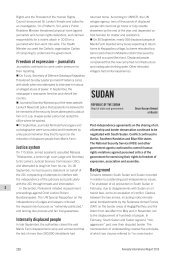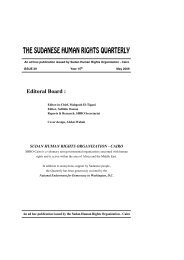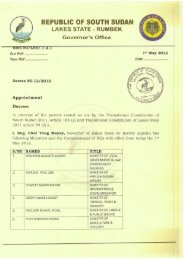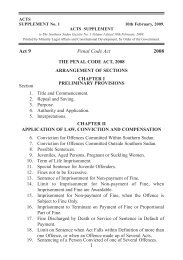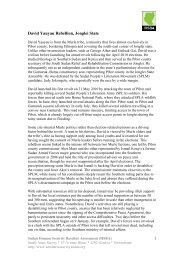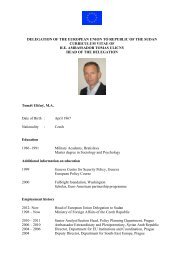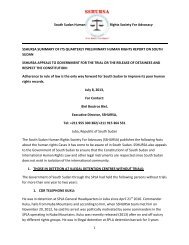The Distribution of Iranian Ammunition in Africa - Conflict Armament ...
The Distribution of Iranian Ammunition in Africa - Conflict Armament ...
The Distribution of Iranian Ammunition in Africa - Conflict Armament ...
Create successful ePaper yourself
Turn your PDF publications into a flip-book with our unique Google optimized e-Paper software.
CONCLUSIONTHE AFRICAN ARMS MARKET IS CHANGING, WITH THEINVOLVEMENT OF NEW SUPPLIERS AND THE APPEARANCE OFNEW SUPPLY VECTORS, BOTH LEGAL AND ILLICIT.unlike Sudan, they do not appear to have <strong>in</strong>volvedthe transfer <strong>of</strong> <strong>Iranian</strong> weapons. Moreover, dates<strong>of</strong> manufacture suggest that these transfers tookplace with<strong>in</strong> a relatively short time period and donot appear to have been repeated—although thiscannot be ruled out.F<strong>in</strong>ally, this report’s f<strong>in</strong>d<strong>in</strong>gs have widerimplications for weapons and ammunitionproliferation <strong>in</strong> <strong>Africa</strong>. First, relatively recentsupplies <strong>of</strong> <strong>Iranian</strong> ammunition emphasise theevolv<strong>in</strong>g nature <strong>of</strong> the market. <strong>The</strong> <strong>Africa</strong>n armsmarket is chang<strong>in</strong>g, with the <strong>in</strong>volvement <strong>of</strong> newsuppliers and the appearance <strong>of</strong> new supplyvectors, both legal and illicit. Exporters such asCh<strong>in</strong>a (and to a lesser extent Iran) appear to beheavily <strong>in</strong>volved <strong>in</strong> the supply <strong>of</strong> weapons to <strong>Africa</strong>nstates that are embroiled <strong>in</strong> armed conflicts.Countries such as Sudan are not simply end users<strong>of</strong> foreign-manufactured materiel, but <strong>in</strong>tensiveredistributors.Second, the f<strong>in</strong>d<strong>in</strong>gs re-emphasise the critical rolethat <strong>Africa</strong>n governments play <strong>in</strong> feed<strong>in</strong>g weaponsand ammunition to illicit markets. Investigations<strong>in</strong> this report pr<strong>of</strong>ile ongo<strong>in</strong>g problems associatedwith either the loss or theft <strong>of</strong> weapons fromgovernment arsenals or deliberate governmentarms supplies to neighbour<strong>in</strong>g <strong>in</strong>surgencies. <strong>The</strong>setwo factors make <strong>Africa</strong>n governments the primary<strong>in</strong>direct source, not only <strong>of</strong> <strong>Iranian</strong> ammunitioncirculat<strong>in</strong>g on illicit markets, but arms andammunition from a host <strong>of</strong> other manufacturers.transfers to <strong>Africa</strong> are relatively recent, they stillencompass a decade <strong>of</strong> activity. <strong>The</strong> fact that thisis the first major report to note Iran’s decade-long<strong>in</strong>volvement <strong>in</strong>dicates a worry<strong>in</strong>g lack <strong>of</strong> capacitydevoted to monitor<strong>in</strong>g illicit proliferation. Despitemillions <strong>of</strong> dollars spent on <strong>in</strong>ternational diplomatic<strong>in</strong>itiatives, such as the UN Programme <strong>of</strong> Action onSmall Arms or the Arms Trade Treaty process, theresources allocated to field <strong>in</strong>vestigations rema<strong>in</strong>slight <strong>in</strong> the extreme.Interested members <strong>of</strong> the <strong>in</strong>ternationalcommunity stand a far greater chance <strong>of</strong> assist<strong>in</strong>g—or pressur<strong>in</strong>g—<strong>Africa</strong>n governments to curtailunchecked arms transfers than they have <strong>of</strong>persuad<strong>in</strong>g emerg<strong>in</strong>g arms producers to abandonnewly found market opportunities. But to do this,the <strong>in</strong>ternational community must <strong>in</strong>vest <strong>in</strong> thenecessary diagnostic side <strong>of</strong> arms control. <strong>The</strong>problem cannot be adequately addressed unless itis fully understood. Donor governments need to actquickly and provide the appropriate resources t<strong>of</strong>ield-based <strong>in</strong>vestigations.Third, these f<strong>in</strong>d<strong>in</strong>gs suggest severe weaknesses<strong>in</strong> the <strong>in</strong>ternational community’s capacity tomonitor—and subsequently address—illicitweapons flows. Although <strong>Iranian</strong> ammunition38<strong>Conflict</strong> <strong>Armament</strong> Research<strong>The</strong> <strong>Distribution</strong> <strong>of</strong> <strong>Iranian</strong> <strong>Ammunition</strong> <strong>in</strong> <strong>Africa</strong>: Evidence from a N<strong>in</strong>e-country Investigation



